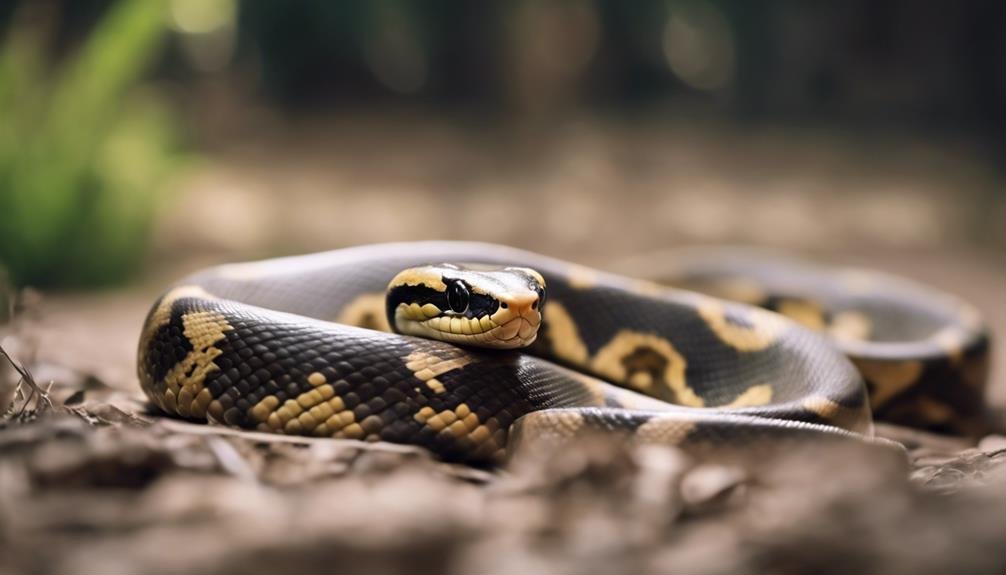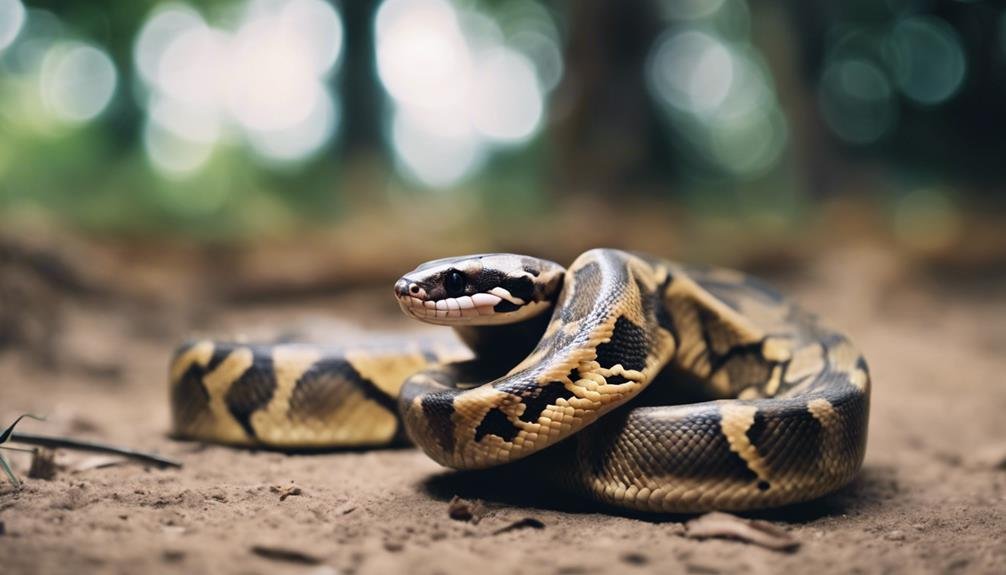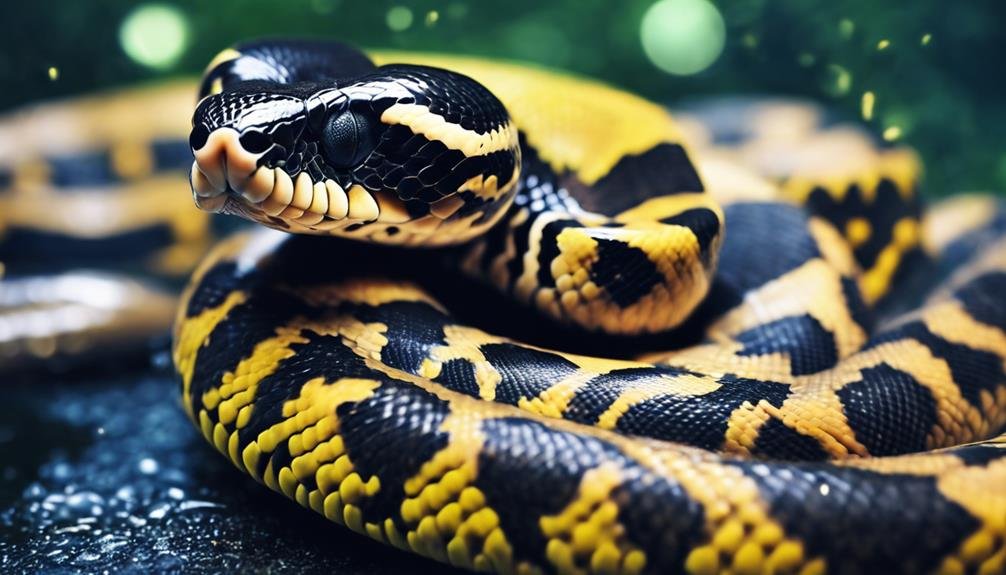You might wonder if your ball python can actually hear you when you talk to them or if they're simply responding to your presence. Surprisingly, while they lack external ears, ball pythons have a fascinating system for detecting sound waves, especially those within the low-frequency range of 80-1000 Hz. Their ability to sense vibrations through their jawbone and an intricate inner ear system offers a glimpse into their unique perception of the world. This sensory skill not only aids in their survival but also influences how they interact with their environment. Let's explore how this specialized sound wave detection system sets them apart and what it means for their care in captivity, leaving you to ponder how best to accommodate their hearing capabilities in your setup.
Key Takeaways
- Ball pythons can detect low-frequency vibrations and sounds, specifically in the 80-1000 Hz range.
- They use the quadrate bone in their lower jaw to sense vibrations in their environment.
- Their inner ear system allows them to pick up on vibrations and potentially detect airborne sounds.
- Ball pythons have a limited hearing range compared to humans, focusing on lower frequencies.
- Research suggests ball pythons may have airborne hearing capabilities, enhancing their environmental awareness and survival.
Ball Python Hearing Capabilities
Ball pythons possess the ability to detect both low-frequency vibrations and high-frequency sounds accurately, despite lacking external ears. You might wonder how they manage this feat. It's all about their keen sensitivity to specific frequencies, ranging between 80-1000 Hz. This range allows them to pick up on vibrations and sounds that are essential for their survival in the wild. They don't need external ears because their bodies are finely tuned to sense these vibrations through other means.
The quadrate bone in their lower jaw is a key player in this unique hearing capability. It acts as a conductor, picking up vibrations from the ground and their surroundings, then transmitting these signals directly to their inner ear. This process enables them to be aware of potential threats or prey nearby without the need for conventional hearing mechanisms.
Recent research has taken this a step further, suggesting that ball pythons may also utilize airborne hearing to detect sounds in their environment. This adaptation is fascinating and shows just how specialized ball pythons have become in interpreting vibrations and sounds to navigate their world effectively.
The Inner Ear System
Delving into the inner workings of a ball python's auditory system reveals a specialized setup that enables these snakes to detect vibrations and potentially hear sounds without the need for external ears. Their inner ear, unlike that of many other creatures, doesn't rely on conventional hearing mechanisms. Instead, it's all about the vibrations caused by their surroundings.
The quadrate bone, pivotal in this unique system, acts as a conduit, transmitting these vibrations directly to the inner ear. This process allows ball pythons to pick up on low-frequency sounds that might indicate the presence of prey or predators. It's a survival mechanism fine-tuned by evolution to suit their stealthy, ground-level existence.
| Feature | Function | Impact on Hearing |
|---|---|---|
| Quadrate bone | Transmits vibrations | Enables detection of low-frequency sounds |
| Inner ear system | Picks up vibrations | Allows for potential sound detection |
| Limited hearing range | Focuses on specific frequencies | Enhances environmental awareness |
This specialized system underlines how ball pythons navigate their world. They're attuned to the vibrations caused around them, giving them a unique perspective on their environment, even without the traditional means of hearing.
Detecting Airborne Sounds


Recent research has discovered that ball pythons may indeed have the capability to hear airborne sounds, expanding our understanding of their sensory world. Unlike what we've long assumed, these silent slitherers aren't deaf to the world above ground. Their specialized inner ear system is finely tuned to pick up on low-frequency airborne sounds, a revelation that adds a new layer to how we perceive their ability to move through their habitat.
Here's what this means for you and your scaly friend:
- Enhanced Sensory Perception: Ball pythons can detect specific sound frequencies in the air, enriching their sensory world beyond just vibrations.
- Communication Potential: This ability may play a role in how they communicate or react to other beings around them.
- Environmental Awareness: It highlights their sensitivity to changes in their surroundings, possibly aiding in predator detection or their spatial orientation within their habitat.
- Care Considerations: Understanding their hearing capabilities can inform how we interact with them, perhaps influencing habitat setup or handling practices to reduce stress.
- Research Opportunities: This opens up new avenues for research into the behavioral implications of airborne sound detection in reptiles.
The discovery that ball pythons can detect airborne sounds not only broadens our comprehension of their capabilities but also deepens the bond between these fascinating creatures and those who care for them.
Comparing Human and Python Hearing
When comparing human and python hearing, it's clear that each species tunes into the world in remarkably different ways. You might be surprised to learn just how different our abilities are when it comes to perceiving sounds.
Humans rely on a wide range of frequencies, from the lowest bass notes to the highest pitches that instruments like violins can produce. Our ears are designed to capture sounds through external and internal mechanisms, making us particularly sensitive to mid-range frequencies. On the other hand, ball pythons don't have external ears at all. Instead, they possess a unique inner ear that's finely tuned to low frequencies, relying heavily on vibration sensing to detect sounds.
The quadrate bone in a python's lower jaw is an essential component of their vibration sensing capability. This adaptation allows them to sense vibrations in their environment, including the bass notes of a guitar, which fall well within their limited hearing range.
Here's a quick comparison:
| Feature | Humans | Ball Pythons |
|---|---|---|
| Hearing Range | 20-20,000 Hz | 80-1,000 Hz |
| Sensitivity | Mid-range frequencies | Low frequencies (vibration sensing) |
| External Ears | Yes | No |
Understanding these differences highlights the unique ways each species interacts with its surroundings, especially when it comes to sound detection.
The Role of Sound in Survival


Understanding how ball pythons use sound to survive reveals the pivotal role their unique hearing abilities play in their daily lives. By tuning into the subtle world of vibrations and low-frequency sounds, these snakes have mastered the art of silent communication and environmental awareness. Their specialized sound wave detection system isn't just about hearing in the conventional sense; it's about sensing the very essence of their surroundings to make vital life decisions.
Here's how sound profoundly impacts their survival:
- Locating Prey: By sensing vibrations, ball pythons can stealthily approach their next meal.
- Avoiding Predators: Subtle sounds alert them to the presence of potential threats, giving them a chance to hide.
- Finding Mates: Vibrations play a role in how they find and communicate with potential partners.
- Navigating Their Environment: Sensing vibrations helps them understand the layout of their terrain, finding shelter and safe spots.
- Interacting with Other Snakes: Through low-frequency sounds, they can engage with their kind, maintaining social bonds or territorial distances.
Each of these points emphasizes the indispensable nature of hearing for ball pythons, transforming vibrations into a lifeline that guides their every move.
Do Ball Pythons Rely on their Special Sound Wave Detection System for Nocturnal Activities?
Yes, ball pythons rely on their special sound wave detection system for their nocturnal behaviors. Their ability to sense vibrations helps them locate prey and navigate their environment in low light conditions. This unique sensory adaptation allows them to thrive as nocturnal hunters in their natural habitat.
Sound Detection in Captivity
Ball pythons in captivity often rely on their specialized inner ear system to detect sound vibrations, adapting even to human speech tones and bass guitar notes. This unique capacity allows them to sense low-frequency sounds within a range of 80-1000 Hz, including ground vibrations that are vital for their awareness and interaction with their environment. You might notice your ball python reacting to your voice or the music you play, showcasing their ability to pick up on these vibrations.
Their hearing adaptations are pivotal for understanding how to create a comfortable living space for them. Since they can detect such a wide array of sounds, it's important to contemplate how everyday noises in your home may affect them. The environment plays a significant role in how well they can hear. Factors like the substrate in their enclosure, how soundproof the room is, and the general noise level can all influence their sound detection capabilities.
Environment Optimization Tips


To guarantee your ball python thrives, it's crucial to create a serene and acoustically tailored environment that caters to their unique hearing needs. Ball pythons are sensitive to vibrations and sounds, which means the ambiance of their habitat can have a notable impact on their well-being. By optimizing their environment, you're not just providing a home; you're establishing a sanctuary that respects their natural inclinations towards certain sound frequencies and vibrations.
Here are some practical tips to enhance your ball python's living space:
- Provide a quiet environment to minimize disruptive sounds that may affect their perception of vibrations.
- Avoid exposing your ball python to loud noises or high-frequency sounds that could lead to stress or discomfort.
- Consider using background noise machines or soundproofing techniques to maintain a calming auditory environment.
- Monitor your ball python's behavior for signs of sensitivity to specific sounds, adjusting their habitat to better suit their hearing preferences.
- Regularly check and maintain the enclosure to ensure it remains a comfortable and acoustically suitable space, free from disturbances that could hinder their unique hearing mechanisms.
Conclusion
So, you've learned that ball pythons have a unique way of 'hearing' through vibrations and low-frequency sounds, thanks to their inner ear system and jawbone. This isn't just fascinating biology; it's crucial for their survival, aiding in finding prey and avoiding predators.
When keeping these incredible snakes, remember the significance of their hearing for their well-being. By minimizing loud noises and creating a calm environment, you'll guarantee your ball python feels safe and comfortable in its home.



[…] lights do not directly affect a ball python’s sound detection system. These snakes rely on their keen senses to detect vibrations and low-frequency sound waves, using […]